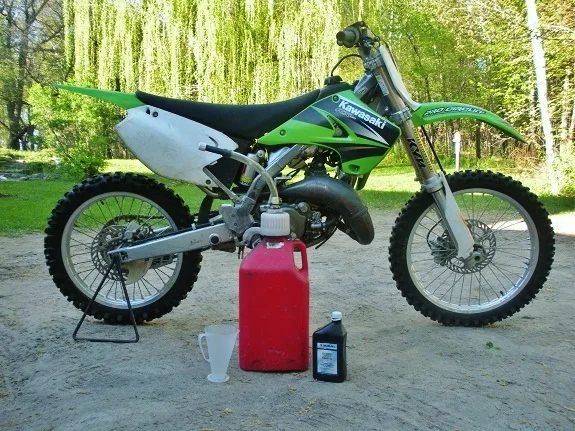Looks like it’s time for a little 2 stroke oil mix ratio (Pre-mix) 101. I don’t usually get into ratio discussions, because mix ratios are like religions to most people, and they tend to be closed-minded and hard-headed on the subject, but I’ll put in my $.02 here anyway.
Anyone that believes that spooge and plug fouling are caused by too much oil in the mix is flat out wrong. If you know how to jet, you can run any amount of oil you choose, and have absolutely zero spooge.
Is it better to use less 2 stroke oil?
There is a prevailing myth that less oil is better. This simply isn’t the case. While there isn’t a magic “one-size-fits-all” mix ratio, and it is possible to use too much oil for your conditions, generally speaking, more oil is better, within certain limitations.
When an engine is jetted too rich, the excess fuel leeches heat from the combustion process, causing the combustion chamber temperatures to be too low to effectively burn the oil, or even completely burn all of the fuel. The result is spooge and deposits. The spooge is nothing more than unburned fuel and oil passing out the exhaust.

Spooge Problem = Jetting Problem?
If you have a spooge problem, you have a jetting problem. You don’t get rid of the spooge by reducing the oil, you get rid of it by fixing the jetting.
Correct jetting will produce an air/fuel ratio of about 14:1, which will produce combustion temperatures in the 6000F range and exhaust temperatures in the 1200F range. This will provide sufficient heat to consume the premix oil.
What Plug Fouling Actually Does
The same goes for plug fouling. Rich jetting does two things. First, it promotes incomplete combustion of the fuel and the oil due to reduced combustion temperatures. The incomplete combustion of the fuel and oil promotes deposit formation inside the engine.
Second, rich jetting reduces the combustion temperatures, which in turn reduces the engines ability to burn off deposits. Combine increased deposit formation with reduced ability to burn off those deposits, and what do you get? Spooge and plug fouling.
You don’t choose a mix ratio based on “spooge” or plug fouling, you choose the ratio based on the amount of oil your engine needs to provide sufficient protection and adequate ring seal. The common misconception is that mix ratios are “one-size-fits-all”, when in fact nothing could be farther from the truth.
The amount of oil that is correct for one rider on his bike may not be enough oil for another rider/bike, or it may be too much oil. It all depends on engine displacement, riding style, and how hard you push the engine.
Calculate The Oil Mix For Your Riding Style
A trail rider on a 500 that never reams the bike out is probably fine on a diet of 50:1, where a super-fast up-and-coming young future pro that screams an 85 ’till the dogs howl the entire time he’s on the track might not get a full day of racing out of an engine on less than 30:1.
Your engine’s oil needs are determined by displacement, rev range, and the loads you put on your engine. And if you’re a trail rider that wants to stay in control so that you don’t crash hard, then I want to quickly show you the basic techniques with my free training guide here.
When you shut your engine down and let it sit, much of the oil drains down into the crankcase and forms a puddle in the bottom. The depth of this puddle is your indicator of whether you are running the correct amount of oil for your engine’s needs.
The proper depth of oil puddle
Ideally, you want this puddle to be between 1/8 and 1/4 inch. If it’s less, you need more oil in your mix. If it’s more, you are running more oil than you need for your conditions.
With that said, to have that amount of residual oil in the crankcase at 50:1 (a ratio made popular by magazines and oil bottles), you can’t be riding very hard, or your bike is jetted richer than necessary simply to deliver enough oil. I arrived at a 32:1 oil mix ratio for my bike with my riding style because that is the amount that gives me the proper amount of residual build-up.
Smaller Bike = More Oil
Small-bore engines require greater oil concentrations than larger engines to achieve the proper amount of residual build-up, because they rev higher and have higher intake velocities. Along the same lines, someone that pushes the engine harder, and keeps the revs higher, also needs to use higher oil concentrations to achieve the proper residual build-up.
When I was much younger and a lot faster, 32:1 wasn’t enough oil for my conditions. I needed 26:1 to have enough oil. And I have run as much as 18:1 with no spooge or plug fouling issues.
Getting The Right Oil Mix Ratio Is Critical
To understand why the mix ratio is so important, you have to understand what happens to the oil in your fuel when it goes into the engine. While the oil is still suspended in the liquid gasoline, it can not lubricate anything. It has about as much lubricity at that point as straight gasoline.
When the gasoline enters the engine, it evaporates, dropping the oil out of suspension. Now that the oil is free, it can lubricate the engine. The oil mist is distributed throughout the engine by the spinning crankshaft and the moving air currents to coat all the internal surfaces.
Oil Doesn’t Burn Straight Out The Exhaust
People believe that the oil just rushes right through a two-stroke along with the fuel, but that just isn’t so. It can take 90 minutes or more for the oil migration through a two-stroke to result in a complete oil exchange on a slow trail ride, and even as much as 5 minutes for a full-throttle 20 minute moto.
More Downfalls To Poor Jetting Habits
The oil eventually makes it into the combustion chamber, where it is either burned, or passes out the exhaust. If the combustion chamber temps are too low, such as in an engine that is jetted too rich, the oil doesn’t burn completely.
Instead, some of it hardens into deposits in the combustion chamber, on the piston, and on the power valve assembly. The rest becomes the dreaded “spooge”.
How to make it all work together
The key to all of this working in harmony is to jet the bike lean enough to achieve a high enough combustion chamber temperature to burn the oil, but also still be able to supply enough oil to protect the engine. If you use enough oil, you can jet the bike at it’s optimum without starving the engine of oil, and have excellent power, with minimal deposits and spooge.
At 50:1 in a small-bore engine, you simply can’t jet very lean without risking a seized engine due to oil starvation.
One small point: No one ever broke an engine by using too much oil.
Rings Need Oil To Seal Properly
Now we come to the issue of ring seal. Simply put, the rings alone can not effectively seal the cylinder. They also need oil to provide a complete seal against the bore surface. And up to a point, more oil will provide a better seal.
I have run Dyno tests on this subject, as a school project in Tech School. We used a Dynojet dynamometer, and used a fresh, broken in top-end for each test.
We used specially calibrated jets to ensure the fuel flow was identical with each different ratio, and warmed the engine at 3000 rpm for 3 minutes before each run. Our tests were performed in the rpm range of 2500 to 9000 rpm, with the power peak of our test bike (an ’86 YZ 250) occurring at 8750 rpm. We tested at 76 degrees F, at 65% relative humidity.
Dyno Results With Different Pre-Mix Ratios
We started at 10:1, and went to 100:1. Our results showed that a two-stroke engine makes its best power at 18:1. Any more oil than that, and the engine ran poorly, because we didn’t have any jets rich enough to compensate for that much oil in the fuel.
The power loss from 18:1 to 32:1 was approximately 2 percent. The loss from 18:1 to 50:1 was nearly 9 percent. On a modern 250, that can be as much as 4 horsepower. The loss from 18:1 to 100:1 was nearly 18 percent. The reason for the difference in output is simple. More oil provides a better seal between the ring and the cylinder wall.
Now, I realize that 18:1 is impractical unless you ride your engine all-out, keeping it pinned at all times. But running reasonable ratios no less than 32:1 will produce more power, and give your engine better protection, thus making it perform better for longer.
The bottom line? Choose a 2-stroke oil mix ratio that is adequate for your needs, and jet accordingly. You don’t fix plug fouling and spooge by adjusting your mix ratio. To get the full scoop on how jetting works and how to jet your dirt bike properly click here.
-Thanks to “Chokey” over at ThumperTalk for this great write-up.



Michael Forrest
Monday 30th of September 2024
1) It may be an error to assume that a normal fuel flow rate thru a jet tested with fuel in a bottle with a jet at its bottom would have the same relative result at the very slow fuel flow rates inside a carburetor. It would be more prudent to test flow rates with very little fuel/oil in the test bottle (which usually is not what is done). 2) It's an error to assume the oil accumulating in the bottom of the crankcase is a good way to determine if enough oil is added to the fuel. That accumulation depends on the distance between chank wheels and crankcase, engine oil density, amount of ethanol in the fuel, outside temperature, engine temperature, etc. 3) Zero spooge is a fantasy. It is only possible with too lean jetting and engine oil without any synthetic oil. Minimal spooge with correct jetting is possible with stingy amounts of synthetic oil. 4) The error in your power testing is not setting the jetting for optimal power with each different fuel/oil ratio. Instead you changed the jetting to compensate for different flow rates thru jets you tested.
Anthony
Wednesday 1st of May 2024
How the heck do you measure the crankcase oil puddle?
Great article :)
Kelley Fager
Thursday 2nd of May 2024
Haha, perhaps with a syringe? Thanks for reading, Anythony!
Tony
Friday 12th of April 2019
So we know when we are running too rich because of the splooge. But how do we know we are running too lean? How did you kmon you needed to go from 32:1 to 26:1? Looking at the spark plug?
Mike Hawksoar
Thursday 3rd of March 2022
Read the article... he's states that you are supposed to measure residual oil in the crankcase ....
emma gillies
Sunday 27th of April 2014
i love motorcrosss bike is there anyplace i can get a good motorcross bike because i, going into races real soon